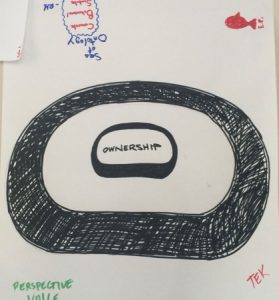Well, our poster was quite simple. But to be fair, Curriculum A is perhaps the broadest of the five cultural standards for curriculum, so it was hard for us (I think) to get a visual hook into it.
I wish I would have drawn my “Sea of Ontology” with the Three levels of culture (Concrete, Behavioral and Symbolic) within it as an Eye because that would have made more metaphorical sense. Ie. the drawn Eye would be the lens that we view culture through, rather than the Greek idea of the sea of knowledge that bounds every life. I also wish that I had drawn it right side up.
It was cool and insightful to see Mischa and Jasmine focus in on the ovoids. They explained that in the Tlingit culture, drawing always starts with an ovoid. Mischa said that other shapes can always fit around an ovoid (I guess because it has three curves and one straight side). Mischa also said (I think) that she sees ovoids first in Tlingit art, while triangles or diamonds aren’t shapes that stand out to her, but tend to do so to people outside of the Tlingit culture and way of knowing. I thought that was super interesting. Anyway, I think our visual representation did evoke these two parts of Curriculum A fairly well:
1. recognizes that all knowledge is imbedded in a larger system of cultural beliefs, values and practices, each with its own integrity and interconnectedness;
- The ovoid of cultural ownership within a larger of ovoid of cultural context of some other kind speaks to #1.
5. provides opportunities for students to study all subjects starting from a base in the local knowledge system.
- Obviously, our poster was centered around symbols that are deeply associated with the local knowledge system – #5. All the other side drawings/text on our poster sprung up in the corners.

Ryan – That is very interesting-how Mischa and Jasmine notice the ovoids first in Native art. A perfect example of how people with different background see things differently. We have to take the time to get to know our students and we must create a safe space for them to express themselves so we can begin to understand how they see the world.
Ryan, thank you for sharing again the deeper meaning and complexity behind your poster. “Simple” is such a weird word, I really don’t think anything is simple, because for example, while your poster didn’t have has many lines or words, it said a lot, and obviously (in your explanation) had a great deal of meaning. That visual is definitely something I could look at for a long time and ponder this cultural standard or other complex subjects!
Hey, Ryan!
As someone who was in a group who also studied Curriculum A, I totally understand that it was a broad concept. But I really loved your group’s visual presentation of the content! Mischa told me a similar thing during one of our group projects about being drawn to ovoids first when viewing artwork, and it helped me to realize how different people are drawn to different things, depending on their cultural identity. Beautiful drawing with your sea of ontology. And I like that it’s upside down- it makes you think about it with a whole new perspective!
I was in your group and what I really like about reading your post is how well organized it is… and well written. (You are an English Lit. guy!) You took feelings I had and put them much more eloquently than I did in my own post.
I really enjoyed our group that day– and having the discussions we did. And also learning about the importance of Ovoids in Tlingit culture. I SEE them in much of the local artwork, but it was really cool to hear about their importance.